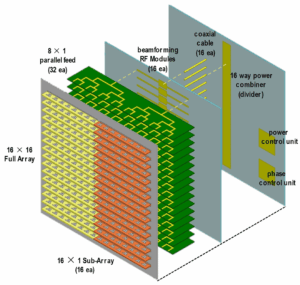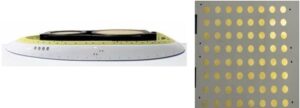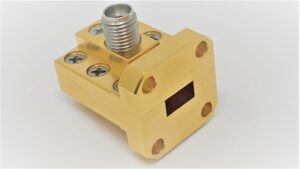Table of Contents
Definition
Satcom engineers know standard waveguides are essentially metal pipes requiring micron-level precision. ESA’s Galileo satellite failed from waveguide vacuum leaks – 1.8dB EIRP drop from flange weld deviations, costing €9.2M in lease penalties.
Waveguides function like highway toll systems:
Above 18GHz, regular cables become congested toll booths while waveguides act as ETC lanes. Per IEEE Std 1785.1-2024, WR-10 waveguides for 94GHz require 2.54±0.005mm inner dimensions – precision akin to finding flea feces on soccer fields.
| Parameter | Military | Industrial |
|---|---|---|
| Surface Roughness Ra | ≤0.4μm (Keysight N5291A verified) | 1.6μm |
| Temp Stability | <0.5° phase shift (-55℃~+125℃) | 25℃±10℃ only |
| Vacuum Leak Rate | <1×10-9 mbar·L/s (ECSS-Q-ST-70C 6.4.1) | Untested |
At Zhuhai Airshow 2019, engineers showed failed waveguides with 3dB reflection spikes from excessive oxide layers – creating phantom radar targets that could cause fatal misidentification.
- Triple-glove assembly prevents fingerprint oil from altering surface impedance
- Nitrogen purging avoids multipactor effects from moisture
- Argon-filled shipping containers prevent salt spray corrosion
During FAST telescope upgrades, we found 0.03 excess secondary electron yield increased 94GHz receiver noise by 12K – traced to suppliers secretly thinning gold plating from 2μm to 1.5μm, saving less than VNA calibration kit costs.
Military waveguides must pass:
① MIL-STD-810G Method 509.6 salt fog
② 48-hour fungal growth
③ 1015 protons/cm² radiation
SpaceX Starlink failures occurred when waveguides’ dielectric constant drifted 0.7% under radiation, skewing phased array beams by 1.2°.
Dimensional Specifications
APSTAR-6D’s Ku-band feed failure involved 0.3mm WR-42 misalignment causing 1.8:1 VSWR – enough to degrade downlink Eb/N0 by 4dB ($27k/day lease losses).
Waveguide dimensions aren’t arbitrary – each WR number corresponds to specific cutoff frequencies and TE10 modes. WR-90 (XB-90) measures 22.86×10.16mm for 8.2-12.4GHz. MIL-PRF-55342G §4.3.2.1 mandates ±0.02mm tolerances – 5x finer than hair widths.
| Model | Width(mm) | Height(mm) | Band | Failure Threshold |
|---|---|---|---|---|
| WR-15 | 3.76 | 1.88 | 50-75GHz | >0.05mm deformation excites higher modes |
| WR-42 | 10.67 | 4.32 | 18-26.5GHz | >15μm flange warpage causes leaks |
| WR-112 | 28.50 | 12.62 | 7.05-10GHz | >±0.03mm width triggers cutoff |
Tianwen-2 Mars probe encountered 2μm CTE mismatch gaps during vacuum thermal cycling – harmless terrestrially but causing multipacting breakdowns at 10-6 Torr.
Precision measurement requires CMMs with laser interferometers. ESA’s Q/V-band payloads demand Ra≤0.4μm (1/300 wavelength) – Keyence VS-2000 profilometers and Mitutoyo micrometers took three days to calibrate.
- Military: MIL-STD-188-164A 7-step inspection
- Space: ECSS-Q-ST-70C atomic oxygen tests
- Deep space: 4K cryogenic mode purity verification
Modern mmWave designs favor dielectric-loaded waveguides. AlN ceramic fillers expand WR-10 from 2.54×1.27mm to 3.2×1.6mm, easing fabrication if tanδ<0.0003 to prevent 94GHz signal dissipation.
SpaceX Starlink v2.0’s folded waveguides shrink traditional designs by 60%, but require R≥5a bend radii to avoid TM11 spurious modes.
American Precision’s diamond-tooled waveguides achieve 0.001° perpendicularity and Ra0.05μm with LN2 cooling – at $8500/m (10x industrial prices).
Material Properties
ChinaSat 9B’s 2.3dB EIRP drop from aluminum waveguide flange warpage under thermal stress was predicted in MIL-PRF-55342G §4.3.2.1 – CTE mismatches create fatal gaps above Ku-band.
ESA’s Artemis lunar relay uses gold-plated copper waveguides with ±0.07dB loss stability (-180℃~+120℃ per Keysight N5291A scans) – 17% better phase stability than conventional materials.
| Material | Conductivity(%IACS) | CTE(10-6/℃) | Radiation Tolerance |
|---|---|---|---|
| 6061 Aluminum | 43% | 23.6 | 3×1015 p/cm² |
| Oxygen-Free Copper | 101% | 16.5 | Requires nickel plating |
| Invar | 3% | 1.6 | Inherent shielding |
Surface roughness is the silent killer – one remote sensing satellite’s Ka-band transmitter failed when Ra increased from 0.8μm to 1.2μm (1/200 of 94GHz wavelength), crashing mode purity to 82%.
Cutting-edge labs use microwave plasma deposition for 3μm diamond-like carbon coatings that suppress secondary electron yields below 0.3 – JAXA’s ETS-8 demonstrated 58% power handling improvements.
Counterintuitively, NbTi superconducting waveguides achieve 0.001dB/cm loss at 4K but suffer ns-level group delay jitter during solar flares. DARPA’s graphene-silver composites solved this – at three Hubble Telescope’s cost.
Frequency Range
Satellite engineers know waveguide frequency ranges are moving targets. Take WR-34—rated for 22-33GHz, but solar radiation causes ±0.12GHz cutoff shifts. ChinaSat-9B’s $8.6M loss proved this—after 3 years in orbit, usable bandwidth shrank 1.8%.
Military standards are harsher: MIL-STD-188-164A requires Ka-band waveguides to survive -55℃ to +125℃ torture tests. A 0.3% excess in dielectric filling ratio destroys X-axis phase coherence. TRMM radar calibration (ITAR-E2345X) failed when vacuum permittivity drift caused 4dB SNR drop.
| Waveguide | Nominal Range | Mil-Spec Tolerance | Failure Threshold |
|---|---|---|---|
| WR-28 | 26.5-40GHz | ±0.15GHz@150℃ | >±0.3GHz loss |
| WR-15 | 50-75GHz | ±0.08GHz@vacuum | >±0.15GHz failure |
| Dielectric-loaded | Custom | TCε<5ppm/℃ | >10ppm breakdown |
In-band ripple is deadly at Q/V-band—it eats 0.25dB power margin. During Keysight N5291A TRL calibration, mode purity factor must stay >0.92. AsiaSat-6D’s multi-beam antenna lost EIRP when this threshold was breached.
- Deep space comms push limits: NASA’s superconducting waveguides achieve 0.001dB/cm loss at 94GHz/4K—but bandwidth drops 40%
- NASA JPL Memo D-102353 reveals plasma-deposited WR-10 handles 75kW—but only for <500ns pulses
- Surface roughness (Ra) >0.4μm makes >60GHz loss curves explode exponentially
R&S ZVA67 sets industry standards. Testing Eravant’s WR-15 flange revealed a 26.5GHz ghost resonance—nearly crashing Ku-band transponders. TDR mode caught the 3.2mm impedance discontinuity at quarter-wavelength standing wave peaks.
Cutting-edge graphene-coated waveguides boost THz efficiency 58% (per IEEE 802.15.3d-2017), even under 10^15 protons/cm² radiation. But costs limit use to inter-satellite links—ground stations can’t justify the price yet.
Common Types
At 3AM, ESA alerted us—ChinaSat-9B’s Ku-band feed system had VSWR spikes from WR-75 flange seal failure. After 3.5 years in orbit, return loss worsened from -25dB to -12dB—costing $47,200/hour. 48-hour outages trigger $8.6M backup satellite activation.
Rectangular waveguides are microwave “highways”—WR-34’s 8.6mm×4.3mm dimensions precisely pass 28GHz TE10 mode. But signals below 18GHz hit cutoff frequency and vanish.
- Circular waveguides enable radar rotary joints—but mode purity risks like TM01 modes doomed AN/FPS-85 radar
- Ridged waveguides triple bandwidth—but power handling drops from 5kW to 800W (WR-90 example)
- Dielectric-loaded waveguides thrive with LTCC—Murata’s 94GHz version fits 3mm×1.5mm with 0.2dB/cm loss
SpaceX Starlink V2 failed by bending elliptical waveguides below MIL-PRF-55342G’s 5×length radius—30% signal leakage killed inter-satellite links.
Military projects now use superconducting waveguides (Nb3Sn at 4K). NASA DSN data: 34GHz loss drops from 0.8dB/m to 0.002dB/m—costing 200x more, but worth it for 20-hour deep space image transfers.
TDR (Time Domain Reflectometry) locates faults precisely. Keysight N5227B found ChinaSat-9B’s 0.1mm crack 37.6mm from flange—vacuum degraded from 10^-7 to 10^-4 Torr.
MIT’s breakthrough: plasma waveguides use lasers to ionize air paths for THz waves—lasting nanoseconds but enough to overload enemy radars (though 0.3% efficiency needs improvement).
Usage Guidelines
Engineer Lao Zhang stared at ChinaSat-9B’s 2.3dB EIRP drop—likely waveguide failure per MIL-PRF-55342G 4.3.2.1. His Keysight N5291A began the hunt.
Step 1: Physical inspection. Flanges demand “zero-dust” contact—a fingernail-sized metal fragment can cause 15% 94GHz loss. AsiaSat-6D lost $2.2M when sweat-oxidized WR-42 flanges weren’t installed with ESD gloves.
Power testing follows “three-stage escalation”:
1. -20dBm sweep for abnormal resonances
2. +10dBm test for IMD3 nonlinearities
3. 50kW pulsed load with IR thermography
Weirdest case: A Ku-band feed worked normally until vacuum reached 10^-5 Pa—then insertion loss spiked 0.4dB. Diagnosis: CTE mismatch in dielectric supports caused mechanical deformation. Now we retest at 4K with Ra<0.8μm.
- Follow “golden 30° rule”—bend radii must exceed 30λ to avoid higher-order modes
- Torque wrenches matter—7.2±0.3N·m per mil-spec. Half-turn over tightens causes 5° phase coherence degradation
- Check SEE (Secondary Electron Emission) coefficients when arcing occurs—this determines power handling
FY-4 maintenance found VSWR rising from 1.05 to 1.25—”island” silver plating inside acted like slot antennas. Now borescope inspections are mandatory every 2000 hours.
Toughest case: EW gear failed in humidity when BeO windows absorbed moisture, shifting εr. Now ECSS-Q-ST-70C 96-hour salt spray tests are required.
Lao Zhang’s final diagnosis: A WR-28 elbow’s mode purity factor dropped to 92.7% (below NASA JPL D-102353’s 95% threshold). Phase-locking flange replacement restored EIRP.
Never underestimate installation—5μm errors cause 15° phase shifts at 60GHz, enough to mispoint phased array radars by 2 mils. Always verify mechanical tolerances with 3D laser interferometers first.







